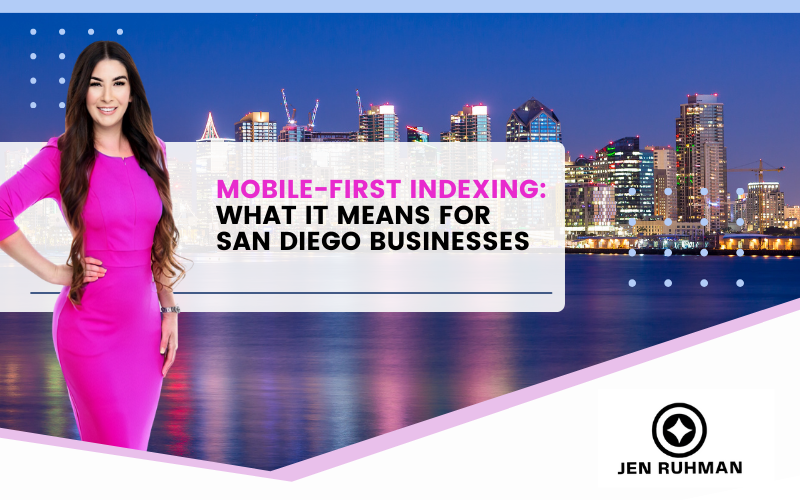Introduction to Mobile-First Indexing
If you run a business in San Diego, your website is probably one of your most valuable marketing tools. But what if I told you that Google isn’t ranking your website based on your desktop version anymore? That’s right—Google now prioritizes mobile versions of websites for indexing and ranking.
This shift, known as mobile-first indexing, means your mobile website version is now the primary factor determining where you appear in search results. If your site isn’t mobile-friendly, it could be affecting your traffic, leads, and revenue.
Let’s dive into what mobile-first indexing means for your San Diego business and how you can optimize your website for this major change.
Understanding Mobile-First Indexing
What is Mobile-First Indexing?
Mobile-first indexing means that Google primarily uses the mobile version of your website for indexing and ranking. This change reflects the fact that most people now browse the internet using mobile devices rather than desktops.
How It Differs from Traditional Indexing
Before mobile-first indexing, Google’s crawlers would evaluate your desktop site first. Now, Google prioritizes how your site looks and functions on mobile. If your mobile site is incomplete or poorly optimized, your rankings could suffer.
When Did Mobile-First Indexing Start?
Google started rolling out mobile-first indexing in 2018 and made it the default for all new websites by 2019. Today, mobile-first indexing applies to almost every website on the internet.
Why Mobile-First Indexing Matters for San Diego Businesses
San Diego’s Mobile-First Consumers
San Diego is a tech-savvy city with a strong mobile-user base. Whether locals are searching for restaurants, service providers, or retail stores, they’re using their smartphones to do it.
Impact on Local SEO Rankings
If your site isn’t optimized for mobile, Google may push your rankings below competitors who have mobile-friendly sites. That means fewer leads, calls, and visits to your business.
The Connection Between Mobile-Friendliness and Traffic
A mobile-friendly site keeps users engaged longer. If your site loads slowly or has navigation issues, users will leave, and Google will take note—dropping your rankings accordingly.
Key Factors Google Considers for Mobile-First Indexing
- Mobile Usability & Responsive Design – Your site must adjust seamlessly to different screen sizes.
- Page Load Speed & Core Web Vitals – Fast-loading pages rank better.
- Content Consistency – Your mobile site should match your desktop site’s content.
- Mobile-Friendly Navigation – Menus, buttons, and forms should be easy to use on smaller screens.
How Mobile-First Indexing Affects SEO
Google’s Ranking Factors for Mobile-First Indexing
- Fast-loading pages (under 3 seconds)
- Text that’s readable without zooming
- No intrusive pop-ups
- Touch-friendly buttons and links
How to Check If Your Site is Mobile-First Indexed
Use Google Search Console to see how Google crawls and indexes your site. Look under “Coverage” and “Mobile Usability” reports for insights.
How to Optimize Your San Diego Business Website for Mobile-First Indexing
- Ensure a Responsive Website – A fully responsive design is non-negotiable.
- Improve Page Speed & Core Web Vitals – Use Google PageSpeed Insights to analyze and optimize.
- Optimize Mobile Content – Short, clear, and easy-to-read text wins.
- Mobile-Friendly Navigation – Make sure menus, buttons, and CTAs are tap-friendly.
- Structured Data & Meta Tags Optimization – Helps search engines understand your content better.
Local SEO and Mobile-First Indexing
The Importance of Google My Business for Mobile Users
Your Google My Business (GMB) profile is crucial for local search. Ensure your information is updated.
Mobile-First and “Near Me” Searches
Most “near me” searches happen on mobile. If you’re not optimized for mobile, you’re missing customers actively searching for your services.
How to Optimize for Voice Search
With the rise of voice search, focus on natural language keywords like “best coffee shop near Gaslamp Quarter.”
If your website isn’t mobile-optimized, you’re losing out on traffic, leads, and customers. San Diego businesses must prioritize mobile-first indexing to stay competitive. Google is prioritizing mobile-friendly sites, and if yours isn’t up to par, your rankings—and revenue—could suffer.
The good news? Optimizing for mobile-first indexing isn’t complicated when you have an expert on your side.
Get Found by More San Diego Customers Today
As a local SEO company in San Diego, I specialize in helping San Diego businesses rank higher in Google. Whether you’re a local startup or an established company, I’ll craft a custom SEO strategy that drives real results.
Want More Customers? Let’s Talk!
✔ No contracts—just affordable SEO services
✔ 100% San Diego-based SEO expert
✔ Get higher rankings, more traffic, and more sales
Call/Text: (619) 719-1315
Let’s grow your San Diego business with local SEO!
FAQs
How do I check if my site is mobile-first indexed?
Use Google Search Console to see how Google indexes your site.What happens if my site isn’t mobile-friendly?
You may experience lower rankings and decreased traffic.How does mobile-first indexing impact ranking in San Diego local searches?
Mobile-friendly sites rank higher, especially for local “near me” searches.Do I need a separate mobile site for better ranking?
No, a responsive website is preferred.What tools can I use to test my site’s mobile usability?
Google’s Mobile-Friendly Test and PageSpeed Insights are great options.


